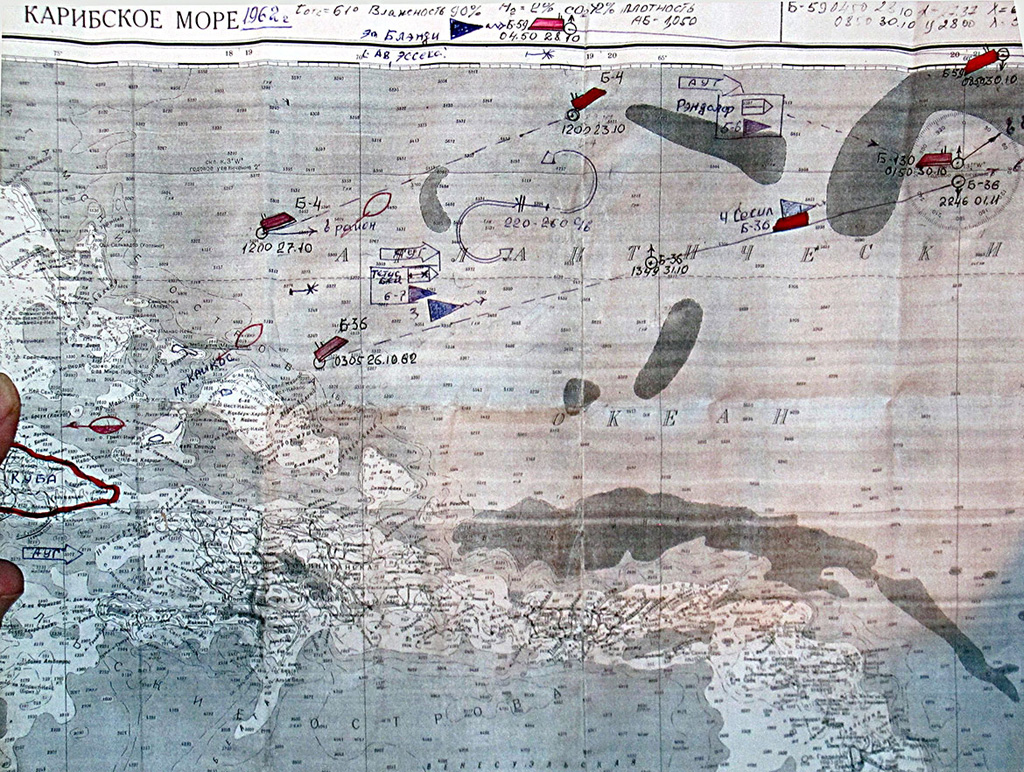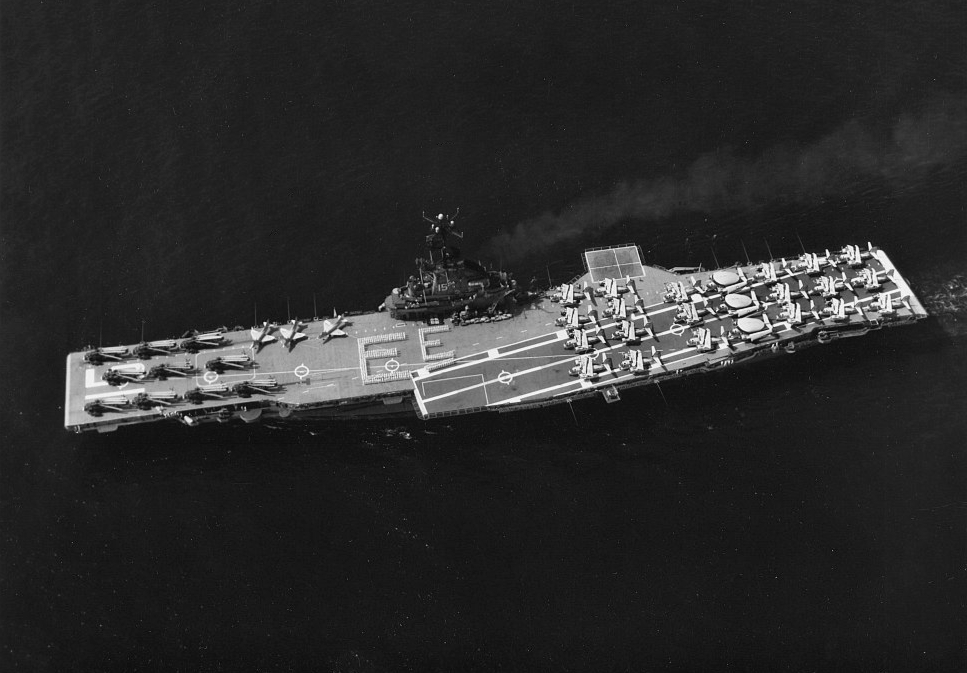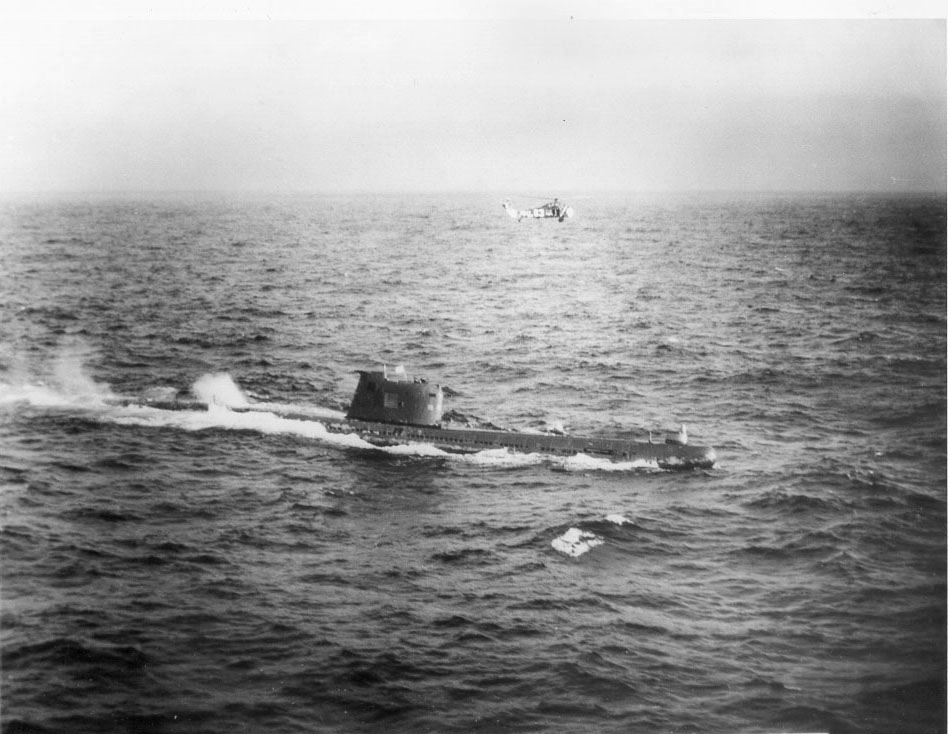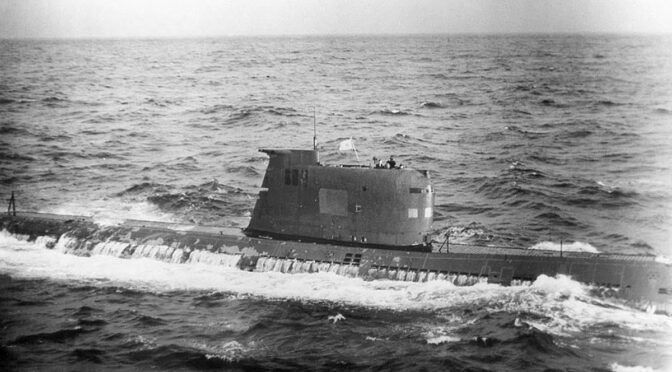The following translation was conducted by Svetlana Savranskaya for the National Security Archive and is republished with permission. Read it in its original form here.
Presentation at the Conference on the Cuban Missile Crisis, October 14, 1997, Moscow. Source: Kirov Naval Academy (National Naval Academy, Baku) website.
By Vice-Admiral Vasili Arkhipov
Before this conference, there has been a lot written, even though in a veiled form, about the Caribbean crisis. [It was published] in mass media, covered in conferences, symposia, roundtables with participation of representatives from all three sides. However, the first time we were informed about the actions of the submarines of the 69th brigade of the Northern Fleet in the operation codenamed “Kama,” it was in the “democratic” newspaper Komsomolskaya Pravda in the middle of 1995, under the odious title “In Case of Ambush—Use Nuclear Weapons.” It was written with the goal—as fashionable at the time as it was vile—to denigrate and defame prominent Soviet military and naval leaders, such as Grechko, Gorshkov, Vershinin, Fokin, Rassokho, and of course, to kick the CC CPSU. The article was part of the plan to destroy the Soviet Armed Forces.
Meanwhile, among the forces engaged in Operation Anadyr, the submarines were in the most critical conditions, closest to using their weapons. Their experience is very instructive and has been critically analyzed by the Navy. Here is [an account of] how they acted.
Submarines B-4, B-36, B-59 and B-130 were given the task to sail secretly from the base to the Cuban port of Mariel. The problem was that the speed of movement was set at twice the one that would allow the subs to travel secretly (in practice, to travel secretly, the diesel submarine could only be at the surface for about 1% of its overall time at sea). On the night of 01.10.1962, the submarines left the Kola Bay with the interval of 30 minutes and started their journey.
During the transit to the Bahamas, there were three most dangerous anti-submarine barriers in terms of the likelihood of being discovered: on the border between the Barents and the Norwegian seas between Medvezhii Island and Nordkap; between Iceland and Faroe and Scottish Islands; and between Newfoundland and the Azores.
During the transit, the weather and visibility generally were conducive to keeping the secrecy—stormy weather, low clouds, low visibility, snow squalls, rain.
The first two barriers exhibited ordinary levels of anti-submarine activity, and the subs crossed them undiscovered.
On the third barrier, which was least studied by our side in terms of its equipment and presence of anti-submarine forces, we observed an elevated level of activity of anti-submarine aircraft radiolocation stations working in a short-interval regime. During crossing of that barrier, on October 18, radio intelligence unit on B-59 intercepted a message from a French radio station informing some correspondents that Soviet submarines entered the Atlantic and were now traveling to the American shores. How they discovered the submarine (or submarines) is hard to say.
American sources say nothing about it either. However, one can say with high confidence that the submarine was not discovered with aircraft radar.
Meanwhile, the U.S. President announced the blockade of Cuba in a televised speech in the evening on October 22.
The U.S. Navy command sent additional ships and aircraft to the Cuban shores and to the Atlantic, and stated that any submarine discovered on approach to the Bahamas must surface to be identified. The commanders of U.S. ships were instructed to be ready to attack if the submarine refused to surface.
Next day, on October 23, submarine commanders were ordered by the Navy Central Command Headquarters to take positions in specified quadrants and conduct reconnaissance. The quadrants were set in several dozen miles [from one another] along their route. The same radiogram warned the commanders about possible U.S. provocative actions against Cuba and our transports. They were ordered to be on full alert and to continue to navigate in secret.
The determined quadrants were cut very poorly, because they did not allow the subs to preserve the secrecy of movement, most likely due to the quickly changing military and political situation around Cuba. They were drawn 300 to 350 miles across from the Bahamas maritime straights. In these waters [the United States] deployed experimental deep-water systems for long-distance submarine detection.

On October 24, the submarines arrived to the designated areas. And at the same time, as Norman Polmar of the U.S. Naval Institute wrote, Khrushchev stated to the U.S. representative in Moscow, in response to Kennedy’s announcement, that if U.S. ships started searching Soviet merchant ships on the high seas, it would be considered piracy and that he would give orders to the Soviet submarines to destroy U.S. ships. The tactical situation around the submarines started to deteriorate rapidly. The activity of ship-borne and shore-based anti-submarine aviation picked up sharply, and then groups of aircraft-carrier-based search-and-attack groups, ASW, entered the areas of submarine deployment: [the group] led by aircraft carrier “Essex”—to the sub B-130 area; led by ASW aircraft carrier “Randolph”—to sub B-59 area; and helicopter-carrier “Tetis-Bay” with escort ships—to sub B-36 area of deployment.
All of them were searching for submarines with all means available to them: radio location stations, multi-frequency sonars, Julie sonobuoys, towed sono-locators, radio hydroacoustic buoys, sonars and so on; and in addition [used] explosions of grenades as a signal to come to the surface. All this banged and echoed in the sections of the submarines for several days, and had a depressing effect on the personnel. In addition, the living conditions on the submarines deteriorated substantially due to the impossibility to ventilate the compartments.

The temperature inside the compartments, due to the high temperature of the sea water of +30-32 C, the work of the regeneration systems, the diesel engines, accumulator batteries and [other] mechanisms, was +50 C; in the diesel compartments and hydroacoustic cabins it reached +60-65 C. On top of that, high humidity, elevated pressure, vapors of fuel, oil, electrolyte, levels of CO2 several times exceeding the norm (1.2%), and lack of drinking water—all this created difficult conditions for the personnel. The submarine mechanisms could not endure the conditions that the men could still bear. The diesels, plugs [pads] for the outboard flaps and valves, water coolers, packing sealants for the shaft lines, broke most often, leading to the seepage of water into compartments and diminishing the depths to which submarines could submerge. Repairing the damage demanded great efforts and perseverance on the part of the personnel. Many sailors, especially engine personnel, were fainting. But then, after some rest and a chance to breathe, they returned to work or reported to watch duty.
In order to avoid giving the audience (or readers) an impression of what kind of battle ships those were, and how they could fight, I have to tell you that failures of equipment were not a rare occurrence and not limited to our country’s ships. For instance, according to the official data, in the period of 1960-1968, the U.S. Navy suffered 35 accidents and catastrophes, not even counting breakdowns (of equipment). Even during the crisis, the ASW aircraft carrier “Randolph” only stayed in the area for several hours and then sent a radio signal “The second main boiler is out of order. I am returning to the base.”
These submarines of the new project, built in 1959-1961, were the best in the world in terms of their combat and technological capabilities. They were armed with 22 torpedos. Their sailing range was up to 26,000 miles; they could sail autonomously for three months and dive to the depth of 300 meters. However, they were still not adapted for sailing in very hot climate, in the conditions of high salinity of water. Their mechanisms were still not fully broken in, tested and lapped. Later, these problems were fixed, and soon after our journey, submarines of this project became the main ships of our Navy on combat duty. And when I am speaking about malfunctions on these submarines, it is only because I want to emphasize the difficult conditions of sailing, under which, for several reasons, it was impossible to fix all the problems, and so they accumulated.

The submarines had to charge their accumulator batteries with many interruptions as they were trying to avoid being discovered by the anti-submarine forces.
The U.S. Navy had an existing tactical protocol against diesel submarines called “hunt to exhaustion,” analogous to the British tactics of fighting against the German submarine fleet during World War II along the Biscay ASW barrier called “war of attrition.” In that case, these tactics were justified and had led to the logical conclusion.
On the night of October 25, U.S. destroyers detected submarine B-130, after which, according to all the American documents, all other ASW forces were directed at it, and the pursuit started. After the accumulator battery got discharged, the submarine came to the surface in the ASW area patrolled by the aircraft carrier “Essex.” As it became known from the memoirs of John Kennedy’s brother Robert Kennedy, the President was informed about the discovery of the submarine on the morning of October 27. This made everybody deeply anxious. He writes: “I think these minutes were the time of gravest concern for the President.” He said, “ Isn’t there some way we can avoid having our first exchange with a Russian submarine— almost anything but that?” But right after that a message came that the Soviet ships stopped. This stage of crisis was over.
However, after this incident, the pursuit [of the submarines] was intensified. And approximately in the same circumstances, submarines B-36 and B-59 were detected, and after three days of pursuit, they had to come to the surface.
I would like to focus on the actions of B-59 as the most typical of them.
Upon surfacing, it discovered [the following]: an aircraft carrier, nine destroyers, four airplanes of Neptune type, three of Trekker, encircled by three concentric circles of coast guard forces. This submarine experienced the entire range of provocative activities of the U.S. forces. Overflights by planes just 20-30 meters above the submarine’s conning tower, use of powerful searchlights, fire from automatic cannons (over 300 shells), dropping depth charges, cutting in front of the submarine by destroyers at a dangerously [small] distance, targeting guns at the submarine, yelling from loudspeakers to stop engines, etc.
We would not need to talk about this except for one crucial question: Why did the submarine not use its weapons?
The battle instructions for the commander state [in] point 8: “during the sea passage, weapons should be in a battle-ready state. Use of conventional weapons— upon the order from the Navy Commander-in-Chief, or in case of an armed attack at the submarine.” Therefore, to use or not to use the weapons depended on how you read the situation: is the fire from the aircraft cannon an armed attack or not? At that time, the events could have developed in the following way: after the first salvo from an aircraft cannon, the commander could have instinctively, without contemplation ordered an “emergency dive”; then after submerging, the question whether the plane was shooting at the submarine or around it would not have come up in anybody’s head. That is war.
But the plane, flying over the conning tower, 1 to 3 seconds before the start of fire turned on powerful searchlights and blinded the people on the bridge so that their eyes hurt. It was a shock. And the commander physically could not give any orders, could not even understand what was happening. And when he blinked and blinked his eyes and could see again, it became clear that the plane was firing past and along the boat. And the subsequent similar actions (there were 12 overflights altogether) were not as worrisome any longer.
To explain the behavior of the commanders, one has to understand the context in which they had to make their decisions. In practice, the submarines had unreliable communications with the Central Command Headquarters. They learned about the developments around Cuba from short intermittent radio intercepts of the U.S. public broadcasting stations. From that information, they made a conclusion that the situation was tense; however, that it was on the verge of war, they only learned after their return to the base, when member of the Military Council of the Northern Fleet, Vice-Admiral Sizov told them during the meeting with the submariners of the 69th submarine brigade: “We did not even expect you to come back alive.”
Conclusions.
1. This was the first encounter between Soviet submarines and the entire complex of the U.S. anti-submarine warfare forces and equipment; in the area, which was extremely unfavorable for our submarines and very favorable for U.S. anti-submarine forces. This encounter led to a reassessment of the U.S. anti-submarine forces both by the Soviet Navy and in the United States. Detection of the submarines became possible as a result of massive concentration of all anti-submarine forces and efforts, which is only possible to sustain for a short period of time. That is understood in the United States as well. This [conclusion] is supported by the fact that both B- 36 and B-59, after completing the charging of their accumulator batteries, were able to get away from their pursuers with relative ease, and submarine B-4, which was spotted by the ASW aviation, after charging its battery was able to successfully escape from the search area.
2. The command of the United States and NATO made certain conclusions from the actions of ASW against the submarines of the 69th brigade, and rapidly increased the number of military exercises of anti-submarine forces. Thus, just in September-October of the following year [1963] they held seven comprehensive military exercises, and the number was increased in the subsequent years.
3. Conclusions and suggestions on the basis of the submarine operations were reported to the command of the 4th submarine squadron and to the Northern Fleet after the submarines’ return to the base. There is no need to repeat them now, because that was the last encounter when the Soviet leadership and the Armed Forces of the USSR stood up to defend its interests as equals with the United States.
4. The journey of the submariners of the 69th brigade deserves appreciation and admiration of the courage, perseverance and patriotism of sailors, non- commissioned staff and officers in extreme conditions of their sail.
Thank you for your attention
Former Chief of Staff of the 69th submarine brigade
Vice-Admiral, Retired,
V. Arkhipov.
Featured Image: Photograph of Soviet submarine B-59 close-up with Soviet crew visible, taken by U.S. Navy photographers, circa 28-29 October, 1962 Source: U.S. National Archives, Still Pictures Branch, Record Group 428, Item 428-N-711201


My Dad was flying S2-Fs from ESSEX during this episode. This is the first article I’ve read from the Soviet submariner’s point of view. As a retired Surface Warfare Officer during the following decades of the Cold War and watched ASW capabilities degrade. Without the “hunter killer” packs and tactics of the late 50s and early 60s, have we ceded this arena of war? Recent articles in CIMSEC advocate it’s return.